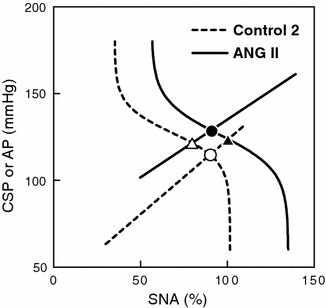Fig. 4.

Equilibrium diagrams between the arterial baroreflex neural and peripheral arcs. The dashed and solid curves represent the open-loop characteristics of the baroreflex neural arc under the control and ANG II-treated conditions, respectively. The dashed and solid lines represent the open-loop characteristics of the baroreflex peripheral arc under the control and ANG II-treated conditions, respectively. The open circle indicates the closed-loop operating point under the control condition. ANG II causes an upward shift in the peripheral arc. If ANG II does not affect the neural arc, the closed-loop operating point would be at the point depicted by the open triangle. In this case, the estimation of baroreflex control of SNA based on the closed-loop operating points (the open circle and open triangle) approximates the slope of the baroreflex neural arc (dashed curve). ANG II, however, causes a rightward shift in the neural arc. Thus, the estimation of the baroreflex control of SNA based on closed-loop operating points (the open and filled circles) does not match the slope of the neural arc under either the control (dashed curve) or ANG II-treated condition (solid curve)
